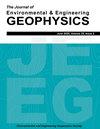基于复合干涉法的掘进机随机源信号脉冲处理算法
IF 0.7
4区 工程技术
Q4 ENGINEERING, GEOLOGICAL
引用次数: 0
摘要
井架掘进机是实现煤矿进煤机械化的主要设备,是主要产煤国家不可缺少的生产设备。掘进机在工作过程中会产生大量的振动;这些振动携带大量能量,因此可视为潜在的震源,用于矿井巷道的地震提前探测目的。与常规探源相比,掘进机探源产生复杂的连续随机信号。地震小波的形状不确定,持续时间较长;因此,必须将其处理成常规脉冲信号,才能用于后续的处理和分析。因此,基于地震干涉测量在随机信号处理方面的优势,引入反褶积和互相关两种地震干涉技术,构建复合干涉算法。在理论推导公式的基础上,利用掘进机现场采集的源信号进行了随机信号脉冲处理实验;这种方法解决了单纯相互关系不能产生理想结果的问题。因此,提出了一种可行的随机信号脉冲处理算法,即复合干扰算法。该算法对每条地震道进行反卷积,压缩后得到参考道和其他接收道。然后,将参考走线与每条接收机走线相互关联,得到每条相关小波脉冲的小波时延信息,即接收机走线相对于参考走线的小波时延信息。因此,直接波和反射波被识别。为了评价算法的性能,对掘进机在不同进煤条件下采集的另一组随机源信号进行了算法应用实验。算法处理结果与爆炸源单发记录特征一致。因此,该算法可以满足工程勘探和分析的要求。综合分析进一步证明了复合干涉算法的可行性和有效性,处理后的地震信号可用于后续的处理和解释。本文章由计算机程序翻译,如有差异,请以英文原文为准。
Impulse Processing Algorithm for Random Source Signals of Roadheaders That Is Based on Compound Interferometry
The boom-type roadheader is the main equipment for realizing the mechanization of coal drifting in coal mines, and it is an indispensable production equipment in major coal-producing countries. Substantial vibrations are generated during the operation of a roadheader; these vibrations carry substantial energy and, thus, can be regarded as a potential source and used for seismic advance detection purposes in mine drifts. Compared with a conventional exploration source, a roadheader source produces a complex continuous random signal. The shape of a seismic wavelet is uncertain and its duration is relatively long; thus, it must be processed into a conventional pulse signal before it can be used for subsequent processing and analysis. Therefore, based on the advantages of seismic interferometry in random signal processing, two seismic interference techniques, namely, deconvolution and cross-correlation, are introduced for constructing a compound interference algorithm. On the basis of a theoretically derived formula, a random signal impulse processing experiment is conducted using field-acquired source signals from a roadheader; this approach resolves the problem that cross-correlation alone cannot yield ideal results. Hence, a feasible algorithm for the impulse processing of a random signal, namely, the compound interference algorithm, is proposed. The algorithm deconvolves each seismic trace to obtain the reference trace and other receiver traces after compressing the wavelet. Then, the reference trace and each receiver trace are cross-correlated, and the wavelet time delay information of each correlated wavelet pulse, namely, the wavelet time delay information of the receiver trace relative to the reference trace, is obtained. Accordingly, the direct wave and reflected waves are recognized. To evaluate the performance of the algorithm, an algorithm application experiment is conducted for another group of random source signals that were collected by a roadheader under different coal drift conditions. Again, the algorithm processing results are consistent with the single-shot record characteristics of an explosive source. Consequently, the proposed algorithm can satisfy the requirements for engineering exploration and analysis. A comprehensive analysis further demonstrates that the compound interference algorithm is both feasible and effective and that the processed seismic signals can be used for subsequent processing and interpretation.
求助全文
通过发布文献求助,成功后即可免费获取论文全文。
去求助
来源期刊

Journal of Environmental and Engineering Geophysics
地学-地球化学与地球物理
CiteScore
2.70
自引率
0.00%
发文量
13
审稿时长
6 months
期刊介绍:
The JEEG (ISSN 1083-1363) is the peer-reviewed journal of the Environmental and Engineering Geophysical Society (EEGS). JEEG welcomes manuscripts on new developments in near-surface geophysics applied to environmental, engineering, and mining issues, as well as novel near-surface geophysics case histories and descriptions of new hardware aimed at the near-surface geophysics community.
 求助内容:
求助内容: 应助结果提醒方式:
应助结果提醒方式:


